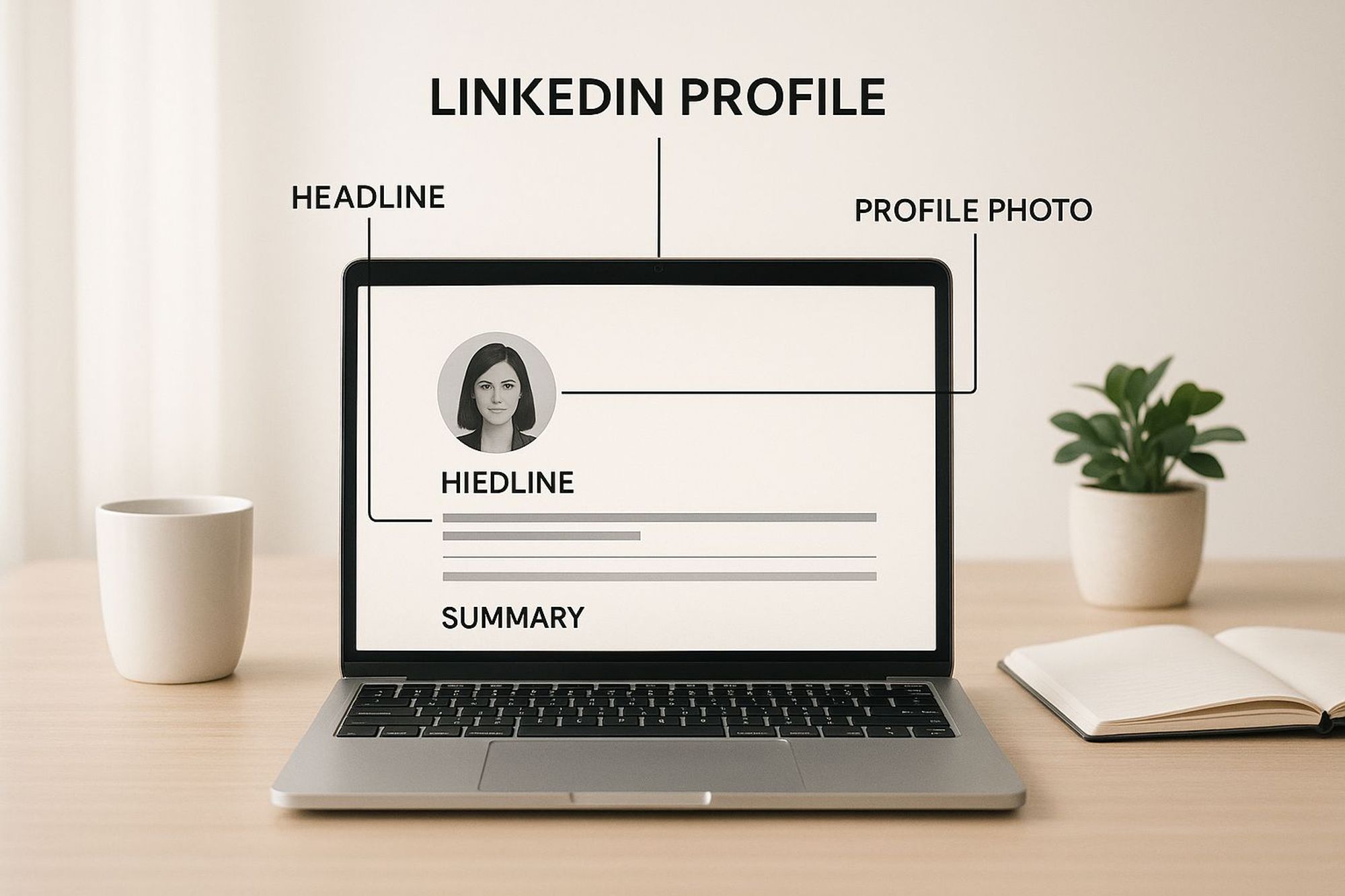Thursday, July 17, 2025
Become an Influencer on LinkedIn: Your Ultimate Guide

When you hear the word "influencer," what comes to mind? For most people, it’s perfectly curated Instagram feeds or the latest viral dance on TikTok. But there's a different kind of influence bubbling up on a platform once known mainly as a digital Rolodex.
LinkedIn has quietly grown from a stuffy, resume-hosting site into a genuine hub for professional authority. This shift has opened up a massive opportunity for experts in any field. Whether you're in software development, marketing, or human resources, you can build real influence.
Why LinkedIn Is the New Frontier for Influencers
Forget aesthetics—on LinkedIn, your value comes from the quality of your insights and the expertise you're willing to share. It's a place where a software engineer can have more pull than a lifestyle guru, simply by sharing what they know.
The numbers don't lie. LinkedIn just blew past the 1 billion member mark and is adding two to three new users every single second. What’s more, Millennials and Gen Z now make up a staggering 76% of its user base, creating a massive, built-in audience that’s hungry for authentic, career-focused content. You can dive deeper into these trends with this detailed breakdown of LinkedIn statistics.
So, what does it actually mean to be an influencer on LinkedIn? It’s not about being famous; it’s about being valuable.
It’s the ability to shape conversations in your industry, build a rock-solid reputation, and open doors to speaking gigs, consulting projects, or new business—all by sharing what you already do every day.
This new frontier is built on a simple, powerful idea: people trust authentic experts. Your day-to-day work, your hard-won lessons, and your predictions for the future are the real currency here. By consistently putting that knowledge out there, you're not just attracting followers; you're building a brand that creates genuine professional opportunities.
Crafting a Profile That Commands Attention
Let's get one thing straight: your LinkedIn profile isn't just a digital CV anymore. Think of it as your professional storefront, your portfolio, and your personal brand headquarters all rolled into one. If you want to become a recognized influencer on LinkedIn, you need to stop treating it like a static document and start building it into an active hub that screams value the moment someone lands on it.
It's less about listing past jobs and more about telling a compelling story of your expertise. This all starts with understanding how to build your personal brand from the ground up. Every single piece of your profile needs to work together to grab attention and build trust.
Optimize Your Core Profile Elements
First up, your headline. This is your personal billboard. It needs to do more than just state your job title; it has to broadcast the value you deliver. So, instead of a flat "Marketing Manager at Company X," try something like, "Helping B2B SaaS Companies Grow | Content Strategy & Demand Generation." See the difference? It immediately tells visitors who you help and how you do it.
Next, let's talk about your "About" section. This is your chance to be human. Don't just spit out a dry list of skills. Weave a narrative. Talk about your professional journey, what gets you fired up about your industry, and the problems you genuinely love to solve. This is where you articulate your mission. For a deeper dive, our guide on building a strong personal brand on LinkedIn has a ton of actionable steps you can use right away.
The image below really drives home how a well-structured profile—with a sharp headline, photo, and summary—creates an instant impression of authority.

As you can see, visitors process your photo and headline first. Those elements are absolutely critical for hooking someone's interest in the first three seconds.
Your profile isn't just a record of your past; it's a strategic tool for your future. Every section should be optimized to attract opportunities and build credibility with your target audience.
Finally, a quick but powerful tip: activate Creator Mode. Flipping this simple switch unlocks follower analytics, the ability to host live videos, and makes "Follow" your primary call-to-action. It's a clear signal to both LinkedIn's algorithm and its users that you're here to share valuable content.
To help you get started, I've put together a quick checklist. Go through your profile and see how it stacks up against these optimization goals.
LinkedIn Profile Optimization Checklist
| Profile Element | Optimization Goal | Key Action |
|---|---|---|
| Profile Photo | Appear professional & approachable | Use a high-quality, clear headshot where you're smiling. |
| Banner Image | Reinforce your brand or value | Create a custom banner with your key message or branding. |
| Headline | Clearly state your value proposition | Go beyond your job title. Use a "I help [X] do [Y] with [Z]" formula. |
| About Section | Tell your professional story | Write a compelling narrative about your mission, skills, and passion. |
| Featured Section | Showcase your best work | Pin your top-performing posts, articles, or links to your portfolio. |
| Experience | Highlight achievements, not just duties | Use bullet points with quantifiable results (e.g., "Increased leads by 35%"). |
| Creator Mode | Signal you're a content creator | Turn it on to get a "Follow" button and access to creator tools. |
Ticking off these boxes is your first real step toward turning a passive profile into an active, influence-building machine. It lays the foundation for all the content and networking you'll do next.
Developing a Content Strategy That Builds Authority

On LinkedIn, influence isn't just handed to you—it’s built, one valuable post at a time. This is why a solid content strategy isn't just a nice-to-have; it's the single most important asset in your toolkit. Without a clear plan, you're basically just shouting into the void. A great strategy makes sure every single piece of content you create is a deliberate step toward becoming the go-to expert in your field.
Think of all your professional knowledge as a massive library. Your content pillars are the main sections of that library—the core topics you're going to completely own. An aspiring influencer on LinkedIn should lock down three to five pillars. These should be specific, hyper-relevant to your target audience, and—just as importantly—genuinely interesting for you to talk about.
For instance, a digital marketer might build their strategy around pillars like:
- SEO for SaaS
- B2B Content Marketing
- Marketing Analytics
These pillars become your North Star, keeping your message focused and consistent. That kind of focus is magnetic; it's what attracts and keeps a dedicated following.
Choosing Your Content Formats
Once your pillars are set, it’s time to think about how you’ll deliver your insights. Different formats serve different purposes, and a smart influencer uses them all strategically.
- Text-Only Posts: These are your go-tos for sharing a quick thought, a personal story, or a provocative question. Their simplicity is their strength, making them incredibly effective for sparking conversations and getting wide reach.
- Carousels (PDFs): Got a complex idea? Break it down. Carousels are perfect for turning complicated topics into digestible, visual slides. Use them to teach a step-by-step process, share a framework, or present key data in a way that’s easy on the eyes.
- Long-Form Articles: This is where you really flex your expertise and build deep authority. Reserve articles for your heavy hitters: in-depth case studies, comprehensive guides, or original research that cements your status as a true thought leader.
The most successful LinkedIn influencers don't just pick one format and stick with it. They blend different content types to keep their audience engaged and show off their expertise from every possible angle.
A critical part of this process is organizing your ideas effectively. A great guide on creating an editorial calendar can give you a solid framework to start with. As your presence grows, you'll find you're also nurturing a community, which requires a skillset much like an online community manager.
Mastering Engagement To Accelerate Your Growth

If consistent posting is the engine of your influencer LinkedIn strategy, then genuine engagement is the high-octane fuel. It’s one thing to broadcast your thoughts into the void; it's another thing entirely to build a real community around your expertise. That’s where the magic happens—turning passive scrollers into an active, loyal audience that not only sees your content but advocates for it.
Think of LinkedIn as a massive, ongoing industry conference. You wouldn't just grab a microphone, shout your opinions, and walk away. You’d work the room, join interesting conversations, and offer your insights. The same principle applies here.
Become An Active Participant
To really kick your influence into high gear, you have to get your hands dirty with engagement. Set aside 15-30 minutes every single day to interact on the platform. It's a small investment with a huge payoff.
- Connect Strategically: Don't just send a bland, generic connection request. Personalize it. Mention a post of theirs you enjoyed or a shared interest. This tiny bit of effort shows you’ve actually paid attention and aren't just trying to rack up numbers.
- Comment With Intention: "Great post!" is a dead-end comment. It adds nothing. Instead, leave a thoughtful response that builds on their point, asks a smart question, or shares a quick, relevant story. Your comments are free advertising for your expertise on someone else's stage.
- Respond To Everyone: When people take the time to comment on your posts, answer them. Every single one. This simple act builds incredible goodwill and, just as importantly, tells the LinkedIn algorithm your content is sparking real conversation. Hello, increased reach.
A great influencer is smart, but an exceptional one is both smart and generous. Your willingness to engage thoughtfully with others is a direct reflection of your value to the community.
Meaningful interaction is what separates the fleeting creators from the ones with lasting impact. For a deeper dive, check out our guide on how to boost your social media engagement. You can also explore different community engagement strategies to really strengthen that connection with your audience.
Using Analytics to Refine and Scale Your Influence
Real growth on LinkedIn isn't about guesswork or just throwing content at the wall to see what sticks. It's a science, and the lab is your analytics dashboard. To truly make a mark and become an influencer on LinkedIn, you have to stop just posting and start analyzing. Think of your analytics as a direct feedback loop from your audience, telling you exactly what they want to see more of.
This data-first mindset is what separates the casual posters from the genuine thought leaders. The heavy hitters on the platform, like Bill Gates with his 36.1 million followers, didn't get there by accident. They understand the ecosystem they're in—a place where an incredible 138 hours of educational content is watched every minute. That signals a massive appetite for valuable insights, which you can learn more about through social media usage statistics on influencermarketinghub.com.
Key Metrics to Track
Don't get overwhelmed by a sea of numbers. To start, just focus on the few metrics that tell you the most important parts of the story. Vanity stats are nice, but these are the numbers that actually drive growth.
- Post Views (Impressions): This is your reach. It tells you how many eyeballs are landing on your content. A big spike here might mean you've hit on a trending topic or a format that the algorithm loves.
- Engagement Rate: This is the big one. It's not just about views; it’s about what people do after they see your post. Likes, comments, and shares, when measured against your views, tell you how deeply your content is connecting with people.
- Follower Demographics: Who are you actually talking to? Check the job titles, industries, and locations of your followers. If you're trying to reach marketing managers in tech, but your audience is mostly students, you have a targeting problem to solve.
Your best-performing content is a blueprint for future success. Deconstruct why a post worked—was it the format, the topic, or the storytelling?—and replicate that formula.
When you do this consistently, you create a powerful feedback loop. You post, you analyze the numbers, and you use what you learned to make your next piece of content even better.
This cycle of continuous refinement is the secret to scaling your influence without burning out. It ensures your efforts become more effective over time, turning your content strategy into a well-oiled machine. It’s also the key to calculating your social media ROI and proving that the time you're putting in is worth it. By consistently analyzing and adapting, you shift your LinkedIn presence from a hobby into a powerful strategic asset for your career.
Answering Your Top Questions About LinkedIn Influence
Jumping into the world of LinkedIn influence can feel like a big leap. It’s totally normal to wonder about the time commitment, what kind of content actually connects with people, or if you even have the "right" background to pull it off. Let's clear the air and tackle those questions head-on so you can start with confidence.
How Long Does It Take to Build Real Influence on LinkedIn?
There’s no magic wand here, but with a solid, consistent strategy, you’ll definitely see the needle move. Most pros who post valuable content 3-5 times per week and spend a little time engaging every day start to feel real momentum within 6 to 12 months.
The goal isn't to go viral overnight; it's about steady, meaningful growth. Think of it like building a house, brick by brick. Every valuable post, insightful comment, and new connection is another brick in your foundation of authority. Just focus on giving genuine value, and your influence will build itself over time.
Do I Need a C-Suite Title to Be an Influencer?
Absolutely not. This is probably the biggest myth about LinkedIn influence. Your authority comes from what you know and how generously you share it—not your spot on the org chart.
Professionals at every single level can build a powerful voice by sharing unique insights and real-world advice from their niche. Your value is in your expertise and your willingness to put it out there for others to learn from.
Influence is earned through demonstrated expertise, not a fancy title. Authenticity and specialized knowledge will always outperform seniority alone.
What Kind of Content Actually Works Best on LinkedIn?
The content that wins on LinkedIn is the stuff that teaches, inspires, or sparks a real conversation. While you can play with a lot of different formats, the most effective posts almost always have a thread of authenticity and value running through them.
Here are a few formats that consistently get the job done:
- Personal stories that share a career lesson or a hard-won piece of wisdom.
- Actionable tips you can package into a clean list or a slick carousel.
- Thought-provoking questions that get your audience to jump in with their own experiences.
- Polls are great for getting quick engagement and taking the pulse of your audience.
The secret is to experiment. Try out different formats, and then dive into your analytics to see what your audience is actually responding to. Once you have a feel for what works, you can level up by exploring community engagement strategies that turn passive followers into a genuine, active community. That's the real game-changer.
Ready to stop guessing and start building your LinkedIn influence with a clear plan? With Schedul, you can map out your content calendar, schedule your posts ahead of time, and analyze what’s working—all from one spot. It’s time to turn your expertise into authority. Try Schedul today and start growing.
No credit card required!
